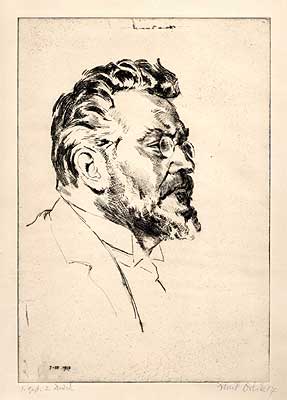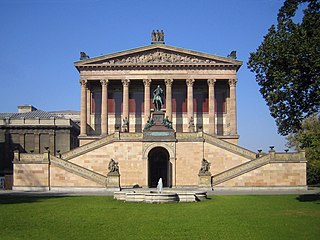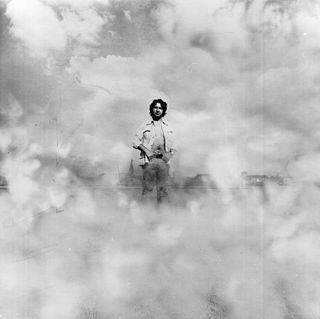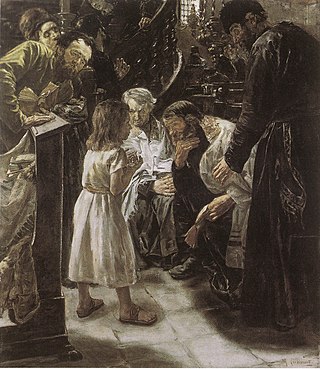
Max Liebermann was a German painter and printmaker, and one of the leading proponents of Impressionism in Germany and continental Europe. In addition to his activity as an artist, he also assembled an important collection of French Impressionist works.

The Neue Pinakothek is an art museum in Munich, Germany. Its focus is European Art of the 18th and 19th centuries, and it is one of the most important museums of art of the nineteenth century in the world.

Max Slevogt was a German Impressionist painter and illustrator, best known for his landscapes. He was, together with Lovis Corinth and Max Liebermann, one of the foremost representatives in Germany of the plein air style.

The Alte Nationalgalerie is a listed building on the Museum Island in the historic centre of Berlin, Germany. The gallery was built from 1862 to 1876 by the order of King Frederick William IV of Prussia according to plans by Friedrich August Stüler and Johann Heinrich Strack in Neoclassical and Renaissance Revival styles. The building's outside stair features a memorial to Frederick William IV. Currently, the Alte Nationalgalerie is home to paintings and sculptures of the 19th century and hosts a variety of tourist buses daily. As part of the Museum Island complex, the gallery was inscribed on the UNESCO World Heritage List in 1999 for its outstanding architecture and its testimony to the development of museums and galleries as a cultural phenomenon in the late 19th century.

The Berlin Secession was an art movement established in Germany on May 2, 1898. Formed in reaction to the Association of Berlin Artists, and the restrictions on contemporary art imposed by Kaiser Wilhelm II, 65 artists "seceded," demonstrating against the standards of academic or government-endorsed art. The movement is classified as a form of German Modernism, and came on the heels of several other secessions in Germany, including Jugendstil and the Munich Secession.
Johannes Karl Holzamer was a German philosopher, pedagogue and former director general of the German television station ZDF.

Gotthard Graubner was a German painter, born in Erlbach, in Saxony, Germany.

The Museum Georg Schäfer is a German art museum in Schweinfurt, Bavaria. Based on the private art collection of German industrialist Georg Schäfer (1896–1975), the museum primarily collects 19th-century paintings by artists from German-speaking countries.

Hans Baluschek was a German painter, graphic artist and writer.

The Landesmuseum Mainz, or Mainz State Museum, is a museum of art and history in Mainz, Germany. In March 2010 it reopened in full after an extensive renovation.

Karl Walther was a painter of the German Post-Impressionist school, and an exponent of plein air painting. His works include portraits, still lifes, cityscapes and landscape paintings.
The Reichsanstalt für Film und Bild in Wissenschaft und Unterricht, before 1940 known as the Reichsstelle für den Unterrichtsfilm was a branch of the Reich Ministry of Science, Education and Culture which was charged with the creation of educational films in Nazi Germany. The office was founded on June 26, 1934, and was headed by Kurt Gauger, a member of the Nazi SA and the Volkssturm.
Der Türmer. Monatsschrift für Gemüt und Geist was the name of a national conservative, Protestant cultural journal, which appeared first in Stuttgart and then in Berlin from 1898 to 1943 and was published for a long time by the Baltic German writer Jeannot Emil von Grotthuß, who lived in Bad Oeynhausen. The name was intended to refer to the tower keeper from Faust, Part Two: "Zum Sehen geboren, zum Schauen bestellt."
Anna Caspari was a German Jewish art dealer who was deported from Germany and murdered by the Nazis in Kaunas in 1941.

Julius Freund was a German entrepreneur and art collector persecuted by the Nazis because he was Jewish.

Leo Lewin was a German merchant, art collector and horse breeder who was persecuted by the Nazis due to being Jewish.

Große Berliner Kunstausstellung , abbreviated GroBeKa or GBK, was an annual art exhibition that existed from 1893 to 1969 with intermittent breaks. In 1917 and 1918, during World War I, it was not held in Berlin but in Düsseldorf. In 1919 and 1920, it operated under the name Kunstausstellung Berlin. From 1970 to 1995, the Freie Berliner Kunstausstellung was held annually in its place.
Gustav Kirstein was a German publisher, writer, and art collector of Jewish descent.

Leo Smoschewer was a German Jewish mechanical engineering entrepreneur and art collector whose business was Aryanized and art collection seized by the Nazis.

The Twelve-Year-Old Jesus in the Temple is an oil on canvas painting by German painter Max Liebermann, created in 1879. It is held at the Hamburger Kunsthalle.















